
The assassination of President John F. Kennedy Jr. on November 22, 1963, ultimately ushered in a decade of turmoil and distress in the United States. The Vietnam War and the Civil Rights movement for African Americans were two of many struggles facing the American people in the 1960s.


